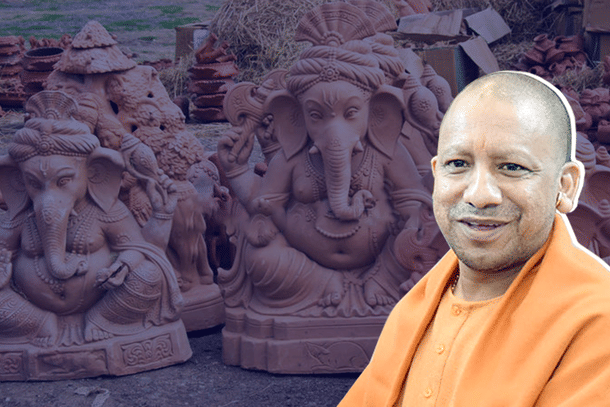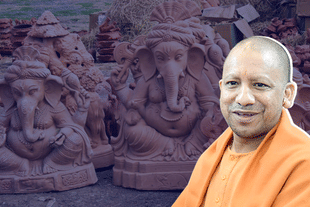Politics
Maati And The Monk: How Yogi Adityanath Used Clay Culture To Propel Skills And Heritage Of A Community
Sumati Mehrishi
Nov 30, 2021, 05:10 PM | Updated 05:10 PM IST
Save & read from anywhere!
Bookmark stories for easy access on any device or the Swarajya app.


On Deepawali this year, Dharamvir Prajapati, a senior leader of the
Bharatiya Janata Party (BJP) from Hathras in west Uttar Pradesh, wanted to
procure around 10,000 mitti diyas or earthen lamps that are used for
celebrations and worship.
The number was hard to find. It so happened that there had been a huge demand for diyas and stocks were over in Agra this year as well. He told this author over the phone: "We tried looking for diyas in entire Agra and we got to know that all stocks were sold three days prior to Deepawali."
This could have been slightly upsetting, but it came as a source of
happiness for Prajapati.
For him, it was an indication that his hard work was showing results and that the people of the Prajapati community were working towards better livelihoods and a good Deepawali.
It was a mission he had signed into under the Mati Kala Board, an initiative from the Yogi Adityanath government in UP that would eventually shape the livelihood prospects of his own community and protect local skills, expression and narrative in the form of state heritage.
Deities and faith have been central to the political landscape of Uttar Pradesh. The worship of Lakshmi and Ganesh became the initiation
point for a new change led by Yogi Adityanath three years ago when the state government started the Mati Kala Board with the motive of encouraging artisans, communities and families engaged in making murtis, diyas, utensils and other objects out of terracotta
and clay and improving their livelihoods.
The worship and depictions of Lakshmi and Ganesh were at the core of this milestone initiative announced in 2018.
However, there was something else built around the emotion for Lakshmi
and Ganesh that came as a pressing need for a board dedicated to Mati
Kala. This was the presence of Chinese-made imitations of the original
and the real.
These would include imitated depictions of Lakshmi and Ganesh, diyas, and other objects meant for decoration. The imitations would sprawl in the Indian market around Deepawali and reach customers and their homes and spaces.
For Yogi Adityanath, who comes with a unique temperament for culture and heritage, their presence was a cultural irritant, and certainly, not a mild one.
Perhaps, the appropriation of the existing art of making Lakshmi and Ganesh in terracotta and clay in the Chinese made imitations that "flood"
the Indian market was garish and visible.
Yogi Adityanath announced the setting up of the board. Its objective made it clear that the celebration of Deepawali in Ayodhya would be marked by diyas from Uttar Pradesh. Advantage small traders. Advantage the chain of hands involved in maati kala.
This was one of the primary reasons for the Adityanath-led government to take a step towards a board that would instill opportunity, training guidance, a good market for real art, the real make, and Indic expression.
The Prajapati community in Uttar Pradesh, for generations, has taken pride in the art of shaping, moulding, sculpting terracotta and clay, giving the medium of mitti time tested expressions for worship and lives.
Mati — or mitti — means soil. As an element or tattva, it has immense
symbolic meaning in the Prajapati community's interaction with the
art.
Diyas, utensils, curios, and other objects created by the artisans
from the Prajapati community, with the depictions of the deities
central to the body of their work, needed intervention.
With an eye on improving sales and exports, training of the artisans and a
convergence into the one district one product (ODOP), the government
actually broke silos that would help in giving maati products greater
chance and visibility.
It automatically was fitting into Narendra Modi's Vocal for Local initiative.
Uttar Pradesh is going to assembly polls in 2022. The good work of the Mati Kala Board may see the community playing a part in the emotion that goes towards Yogi Adityanath in the assembly polls next year.
A bit about Dharamvir Prajapati, first. He has served the party and the government in the past. When he got the responsibility of heading the Board as its president, it was time to use his organisational abilities in making the vision of the Board actually reach the ground.
Dharamvir Prajapati is known for his experience in working on the ground prior to the 2017 assembly polls in Uttar Pradesh and other poll bound states after 2017.
In the beginning of his tenure as president of the Mati Kala Board, Covid-19 appeared as the spoiler. Prajapati told Swarajya that it did not stop them from travelling across the state for collating ground responses from artisans who earn livelihoods from terracotta and clay work.
Prajapati, known for his organisational abilities, says he travelled across 60 districts of UP to get a closer look at the nuances associated with people of the community, the work they do and the problems they face.
A two-pronged awareness approach was made towards two important sets
— the community of "kumhaars" itself and the public as consumers.
Spreading awareness on the importance of maati kala and mitti bartan
(utensils) became a priority task.
Exhibition facilities were given to the community to help the consumers have a direct access to the art. The task was to increase awareness and provide exhibition facilities to each district. The board was in the process of collecting data from the field in response at the different exhibitions after Deepawali.
Khadi Gramodyog would play a pivotal role in holding together interactions between the the artisan, the community and the consumer. The collaboration between the Board and Khadi Gramodyog would ensure that each and every idea behind the interaction between the art, the artisan, the community and the consumer was woven effectively.
The community was told about how the entire family can engage in the
making of mitti articles and support itself as a unit by taking charge
of the desired change.
They were told about the programme, the loan facility for machinery and its benefits, and the resulting increase in operations and livelihood. They were told that 25 per cent margin money of the loan would be reimbursed by the bank.
The training programme was designed for different needs. The first is a seven-day programme that trains the community in various aspects related to the community's livelihood, for example, packaging, accountancy, marketing, etc.
There is a 15-day programme which provides training in finer aspects related to the art itself. Inter-district diversity is encouraged in artisans and awards are given on the basis of quality with entries coming from 18 mandals from across the state.
Deepawali-centric sales at the 10-day exhibition at the Lucknow chapter was a good indicator when it came to response from the public. This
exhibition alone featured work from Gorakhpur, Azamgarh, Khurja and
other districts at 70-72 stalls.
Here are some of the soft and effective tools used by the Board:
One: a documentary on maati kala heritage of Uttar Pradesh. This
documentary would be shown across the state and fall under the
responsibility umbrella of the Zila Gramudyog Adhikaris. Information
on the facility of loan of Rs 10 lakh is spread alongside.
Two. A special dye created for the Ganesh and Lakshmi idols — this
would not only add aesthetic and visual strength to the creations but
help people to distinguish between genuine and beautiful depictions from
cheaper China-made imitations.
Three: Directions were given to Khadi Gramodyog to keep the
creations in a unique display in order to help increase demand.
Four: The importance of using new equipment and the value of old
equipment were highlighted.
Five: A database was created of how many people are associated with
maati kala in the state. Data collection is ongoing and around 46,000
people have been identified in the state.
Six: Pattas (patches/stretches of land from where the maati is dug for
use) are the backbone of the community involved in maati kala. Nearly
14,000 pattas have been identified in the state. The work of the Board
includes ensuring that people in the communities find the pattas and
that the use of the pattas takes place in a smooth way without
disputes. Every district has a patta target in each financial year and
the Board keeps a watch on how many pattas are given to people in each
district. Pattas are given for 10 years and they are subject to
renewal. Nearly 26,000 were given access to pattas; work is ongoing
and information is being collated on how many people are without use
access to pattas. The Board is working on making the reach better and
coordinates with the district administration when the need arises.
Seven: the potters' wheel — the spiritual essential — was at the
centre of the programme. Free chaaks were distributed. A three-day
training programme was brought in to ensure that people in the
community find it easy to operate the new equipment associated with
the art in order to make their work and activity more convenient.
The programme was named "adhunik upkaran sanchalan prashikshan". They were introduced to equipment needed for preparing the maati, for sifting it. They were also introduced to a variety of furnaces, including
those run on electricity and diesel.
Eight: Encouraging co-working with the help of samooh (group) at the
common facility centres, that would absorb an input worth Rs 10 lakh,
in the districts. Machinery, water connection, material, tool kit etc.
are provided to a group of 10-21 artisans. If the groups work well,
the facility centres bear the capacity of turning it into a factory kind
of unit.
In the process, a generational shift was placed in. Prajapati says
that sales of the diyas alone have gone up by 70 per cent.
"People dependent on art and related livelihoods have been satisfied. Those involved in black pottery have witnessed a rise in incomes. I know of
a person from Azamgarh who returned to his village from Maharashtra to
embrace his generational art of maati kala. He had given it up and set
up a street food stall in Maharashtra for livelihood. When he heard of
the work of the Mati Kala Board, he felt assured."
A set of articles and utensils of clay in the existing hubs, such as
Khurja, Kannauj, Gorakhpur and Azamgarh, have been identified for the
focus and pitch in production and sale (with added focus on
exhibitions in the districts).
The growing popularity of Mitti ka tava and the growing sales in diyas is just a trickle effect of the efforts from the Board, Prajapati told Swarajya.
He adds that those selling diyas make between Rs 1 lakh to Rs 70,000 just from their Deepawali sales. Incomes have gone up.
However, Prajapati says, people's hesitation in taking loans was a challenging area. "I covered 60 districts on priority basis to increase awareness and to strengthen communication."
Has the Prajapati community and other communities involved in maati
kala welcomed the change?
BJP leader and MLA Brajesh Kumar Prajapati says that the work done by the board has left a positive impact on the communities. "People who have received the pattas, electric chaaks free of cost and other equipment free of cost are happy. They are being encouraged to form groups so that they can work together at facility centres."
Yogi Adityanath's experiment to harness the available human and
heritage strengths is an underrated cultural prototype that states,
especially the BJP-ruled ones, can look towards in the coming years.
He has been able to build a true connection between art, aesthetics,
people, culture and local economies in a result oriented approach
using just one element — Maati.
Sumati Mehrishi is Senior Editor, Swarajya. She tweets at @sumati_mehrishi





